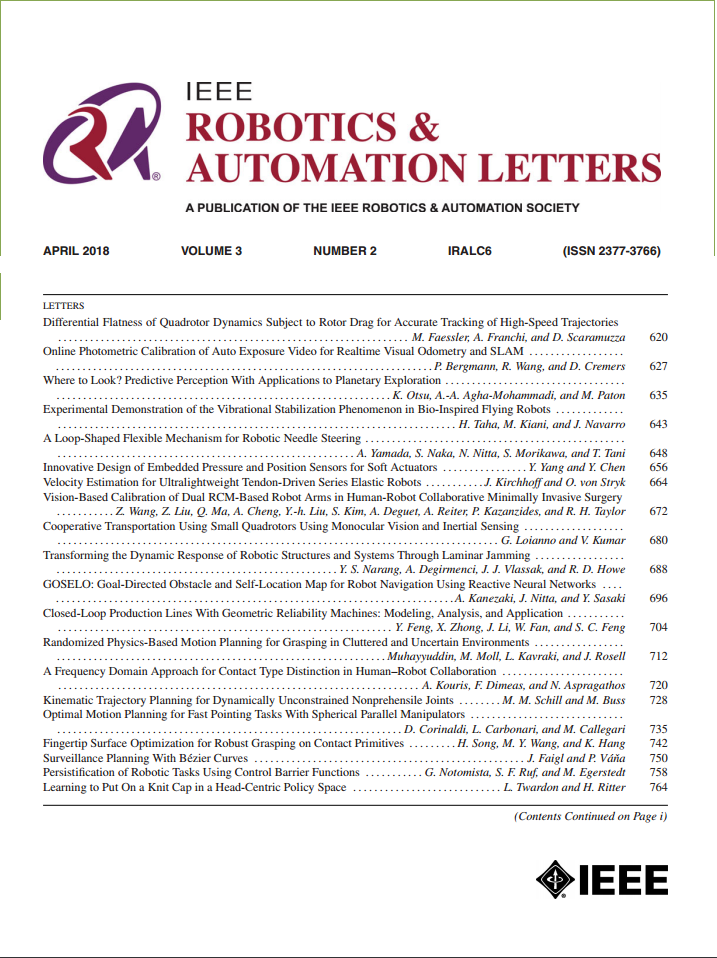基于抓取矩形校正和加权最近邻关系网络的抓取分类机器人分类
IF 4.6
2区 计算机科学
Q2 ROBOTICS
引用次数: 0
摘要
在混乱的环境中,机器人分拣仍然面临着重大挑战,尤其是在资源有限的硬件环境下。传统的检测和抓取工作流程通常需要大量的图像收集和注释来进行模型训练,当排序对象的类别频繁变化时,这可能变得不切实际。为了克服这一问题,本文提出了一种基于深度学习的物体抓取和分类算法的抓取分类机器人分类方法,该方法可以部署在资源受限的硬件平台上。为此,引入了抓取矩形校正(GRC)算法来调整生成残差卷积神经网络(GR-ConvNetv2)生成的抓取姿态。在此基础上,提出了一种有效的加权最近邻关系网络(WNNRNet),用于小目标分类。该模型将深度近邻神经网络(DN4)与关系网络相结合,通过特征共享减少过拟合,并结合加权多任务损失函数进行联合训练,增强了少镜头分类的泛化能力。在Cornell、Jacquard和MiniImageNet数据集上进行了模拟测试以验证GRC和WNNRNet算法。最后,建立了一个带有UR10机器人和Kinect摄像头的机器人分拣系统,进行现实世界的分拣测试,以证明所提出方法的有效性。得益于GRC算法对抓取姿态的有效校正以及WNNRNet需要有限样本进行训练的事实,该方法可以部署在消费者级笔记本电脑上,用于在不同类别的场景中对堆叠对象进行排序。本文章由计算机程序翻译,如有差异,请以英文原文为准。
Grasp-and-Classify Robotic Sorting With Grasping Rectangle Correction and Weighted Nearest-Neighbor Relation Network
Robotic sorting in cluttered environments still faces significant challenges, especially with resource-constrained hardware. Traditional detect-and-grasp workflows usually require extensive image collection and annotation for model training, which can become impractical when the categories of the sorted objects frequently change. To overcome this issue, this article proposes a grasp-and-classify robotic sorting method with deep learning-based object grasping and classification algorithms which can be deployed on resource-constrained hardware platforms. To do this, a Grasping Rectangle Correction (GRC) algorithm is incorporated to adjust the grasping poses generated from the Generative Residual Convolutional Neural Network (GR-ConvNetv2). Then, an efficient Weighted Nearest-Neighbor Relation Network (WNNRNet) is developed for few-shot object classification. This model unifies Deep Nearest Neighbor Neural Network (DN4) and Relation network to reduce overfitting through feature sharing, and the joint training with a weighted multi-task loss function can enhance the generalization capability of few-shot classification. Simulation tests have been carried out to validate the GRC and WNNRNet algorithms with Cornell, Jacquard, and MiniImageNet datasets. Finally, a robotic sorting system with a UR10 robot and a Kinect camera has been built to perform real-world sorting tests to demonstrate the effectiveness of the proposed method. Benefited from the efficient correction of the grasping pose with the GRC algorithm and the fact that the WNNRNet requires limited samples for training, the proposed method can be deployed on a consumer-level laptop for sorting stacked objects in scenarios with varying categories.
求助全文
通过发布文献求助,成功后即可免费获取论文全文。
去求助
来源期刊

IEEE Robotics and Automation Letters
Computer Science-Computer Science Applications
CiteScore
9.60
自引率
15.40%
发文量
1428
期刊介绍:
The scope of this journal is to publish peer-reviewed articles that provide a timely and concise account of innovative research ideas and application results, reporting significant theoretical findings and application case studies in areas of robotics and automation.
 求助内容:
求助内容: 应助结果提醒方式:
应助结果提醒方式:


